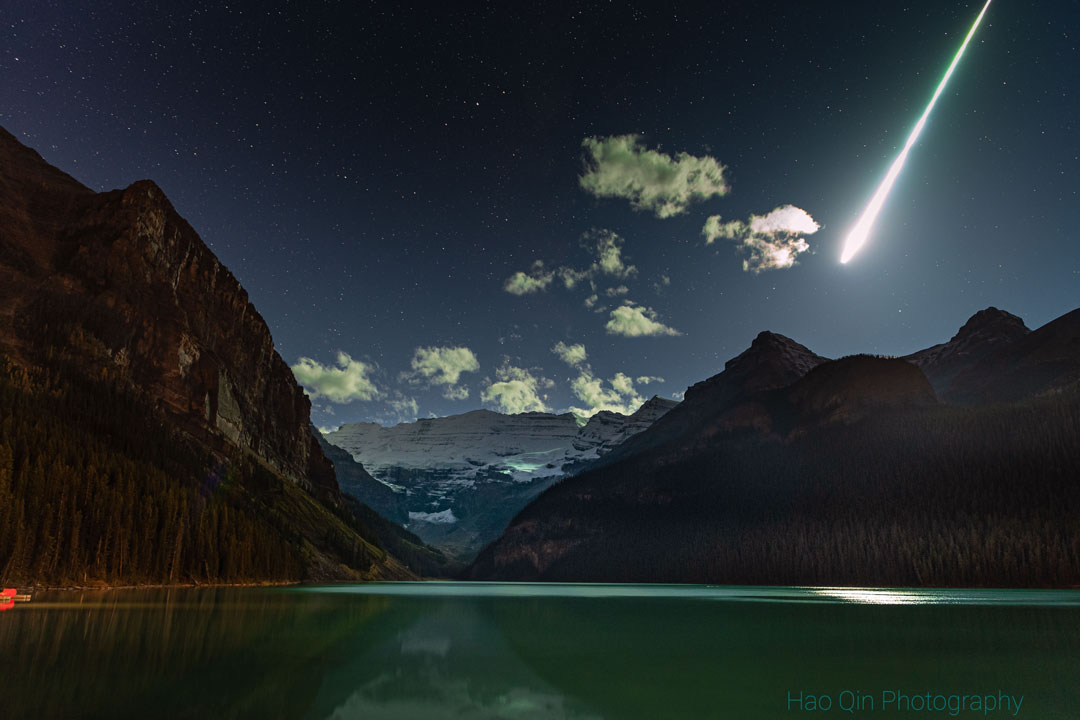12. October 2021
Louise 湖天頂 ê 火流星

探索宇宙1!逐工會揀一幅無仝款 ê 影像抑是相片,𤆬你熟似咱這个迷人 ê 宇宙,閣有專業天文學者2為你3解說4。
- 原始文章:Fireball over Lake Louise
- 影像來源 kah 版權:Hao Qin
- 台文翻譯:An-Li Tsai (NCU)
[漢羅] Louise 湖天頂 ê 火流星
火流星是按怎會遮爾光? 咱愛先知影 火流星 是異常明亮 ê 流星。 國際天文聯合會 kā 比 視星等 -4 閣較光 ê 流星,定義做火流星。 這个光度差不多比所有 ê 行星閣較光,嘛光到 咱會注意著 伊會照出烏影。 天文攝影師 leh 翕這張 長時間感光相片 ê 時陣,拄仔好翕著這粒流星。 伊生目睭毋捌看過遮爾光 ê 流星。 這是 火流星 無毋著! 這個月初,這粒太空石頭當 leh 碎--去。 Kan-na 2 秒鐘 ê 時間,伊 to̍h tī 天頂產生足光 ê 光巡,kā 暗暝變甲敢若日時仝款。 這張相片 ê 前景是 加拿大 Alberta ê Louise 湖。 為著欲予前景 ê 湖較明顯 leh,攝影師有 kā 火流星 ê 光度放較暗 leh。 雖罔講 火流星 真罕得看著,毋閣足濟人攏真好運,有看著 in。 你若是看著 火流星,你嘛會當 kā 國際流星組織通報。 若是有超過一个人有記錄著 火流星 ê 影像,無定著 to̍h 會當 追蹤 伊是 ùi 太陽系 佗一粒天體 噴--出來 ê。
[POJ] Louise ô͘ thiⁿ-téng ê Hóe-liû-chhiⁿ
Hóe-liû-chhiⁿ sī án-ná ē chiah-nī kńg? Lán ài seng chai-iáⁿ hóe-liû-chhiⁿ sī ī-siông bêng-liōng ê liû-chhiⁿ. Kok-chè-thian-bûn-liân-ha̍p-hōe kā pí sī-seng-téng hū-sì koh-khah kńg ê liû-chhiⁿ, tēng-gī chò hóe-liû-chhiⁿ. Chit-ê kng-tō͘ chha-put-to pí só͘-ū ê kiâⁿ-chhiⁿ koh-khah kńg, mā kng kàu lán ē chù-ì tio̍h i ē chiò-chut o͘-iáⁿ. Thian-bûn liap-iáⁿ-su leh hip chit-tiuⁿ tn̂g-sî-kan kám-kng siòng-phìⁿ ê sî-chūn, tú-á-hó hip-tio̍h chit-lia̍p liû-chhiⁿ. I siⁿ ba̍k-chiu m̄-bat khòaⁿ-kòe chiah-nī kng ê liû-chhiⁿ. Che sī hóe-liû-chhiⁿ bô-m̄-tio̍h! Chit-kò-goe̍h-chhe, chit-lia̍p thài-khong chio̍h-thâu tng-leh chhùi--khì. Kan-na nn̄g-bió-cheng ê sî-kan, i to̍h tī thiⁿ-téng sán-seng chiok kng ê kng-sûn, kā àm-mî piàn-kah ká-ná ji̍t-sî kāng-khoán. Chit-tiuⁿ siòng-phìⁿ ê chiân-kéng sī Ka-ná-tà Alberta ê Louise ô͘. Ūi-tio̍h-beh hō͘ chiân-kéng ê ô͘ khah bêng-hián leh, liap-iáⁿ-su ū kā hóe-liû-chhiⁿ ê kng-tō͘ pàng khah-àm leh. Sui-bóng-kóng hóe-liû-chhiⁿ chin hán-tit khòaⁿ-tio̍h, m̄-koh chiok-chōe-lâng lóng chin hó-ūn, ū khòaⁿ-tio̍h in. Lí nā-sī khòaⁿ-tio̍h hóe-liû-chhiⁿ, lí mā ē-tàng kā Kok-chè-liû-chhiⁿ-cho͘-chit thong-pò. Nā-sī ū chhiau-kòe chi̍t-ê-lâng ū kì-lo̍k tio̍h hóe-liû-chhiⁿ ê iáⁿ-siōng, bô-tiāⁿ-tio̍h to̍h ē-tàng tui-chong i sī ùi thài-iông-hē tó-chi̍t-lia̍p thian-thé phùn--chhut-lâi ê.
[KIP] Louise ôo thinn-tíng ê Hué-liû-tshinn
Hué-liû-tshinn sī án-ná ē tsiah-nī kńg? Lán ài sing tsai-iánn hué-liû-tshinn sī ī-siông bîng-liōng ê liû-tshinn. Kok-tsè-thian-bûn-liân-ha̍p-huē kā pí sī-sing-tíng hū-sì koh-khah kńg ê liû-tshinn, tīng-gī tsò hué-liû-tshinn. Tsit-ê kng-tōo tsha-put-to pí sóo-ū ê kiânn-tshinn koh-khah kńg, mā kng kàu lán ē tsù-ì tio̍h i ē tsiò-tsut oo-iánn. Thian-bûn liap-iánn-su leh hip tsit-tiunn tn̂g-sî-kan kám-kng siòng-phìnn ê sî-tsūn, tú-á-hó hip-tio̍h tsit-lia̍p liû-tshinn. I sinn ba̍k-tsiu m̄-bat khuànn-kuè tsiah-nī kng ê liû-tshinn. Tse sī hué-liû-tshinn bô-m̄-tio̍h! Tsit-kò-gue̍h-tshe, tsit-lia̍p thài-khong tsio̍h-thâu tng-leh tshuì--khì. Kan-na nn̄g-bió-tsing ê sî-kan, i to̍h tī thinn-tíng sán-sing tsiok kng ê kng-sûn, kā àm-mî piàn-kah ká-ná ji̍t-sî kāng-khuán. Tsit-tiunn siòng-phìnn ê tsiân-kíng sī Ka-ná-tà Alberta ê Louise ôo. Uī-tio̍h-beh hōo tsiân-kíng ê ôo khah bîng-hián leh, liap-iánn-su ū kā hué-liû-tshinn ê kng-tōo pàng khah-àm leh. Sui-bóng-kóng hué-liû-tshinn tsin hán-tit khuànn-tio̍h, m̄-koh tsiok-tsuē-lâng lóng tsin hó-ūn, ū khuànn-tio̍h in. Lí nā-sī khuànn-tio̍h hué-liû-tshinn, lí mā ē-tàng kā Kok-tsè-liû-tshinn-tsoo-tsit thong-pò. Nā-sī ū tshiau-kuè tsi̍t-ê-lâng ū kì-lo̍k tio̍h hué-liû-tshinn ê iánn-siōng, bô-tiānn-tio̍h to̍h ē-tàng tui-tsong i sī uì thài-iông-hē tó-tsi̍t-lia̍p thian-thé phùn--tshut-lâi ê.
[English] Fireball over Lake Louise
What makes a meteor a fireball? First of all, everyone agrees that a fireball is an exceptionally bright meteor. Past that, the International Astronomical Union defines a fireball as a meteor brighter than apparent magnitude -4, which corresponds (roughly) to being brighter than any planet -- as well as bright enough to cast a human-noticeable shadow. Pictured, an astrophotographer taking a long-duration sky image captured by accident the brightest meteor he had ever seen. Clearly a fireball, the disintegrating space-rock created a trail so bright it turned night into day for about two seconds earlier this month. The fireball has been artificially dimmed in the featured image to bring up foreground Lake Louise in Alberta, Canada. Although fireballs are rare, many people have been lucky enough to see them. If you see a fireball, you can report it. If more than one person recorded an image, the fireball might be traceable back to the Solar System body from which it was ejected.
詞彙學習
| 漢羅 | POJ | KIP | 華語 | English |
|---|---|---|---|---|
| 火流星 | hóe-liû-chhiⁿ | hué-liû-tshinn | 火流星 | fireball |
| 流星 | liû-chhiⁿ | liû-tshinn | 流星 | meteor |
| 國際天文聯合會 | Kok-chè-thian-bûn-liân-ha̍p-hōe | Kok-tsè-thian-bûn-liân-ha̍p-huē | 國際天文聯合會 | International Astronomical Union |
| 視星等 | sī-seng-téng | sī-sing-tíng | 視星等 | apparent magnitude |
| 國際流星組織 | Kok-chè-liû-chhiⁿ-cho͘-chit | Kok-tsè-liû-tshinn-tsoo-tsit | 國際流星組織 | International Meteor Organization |